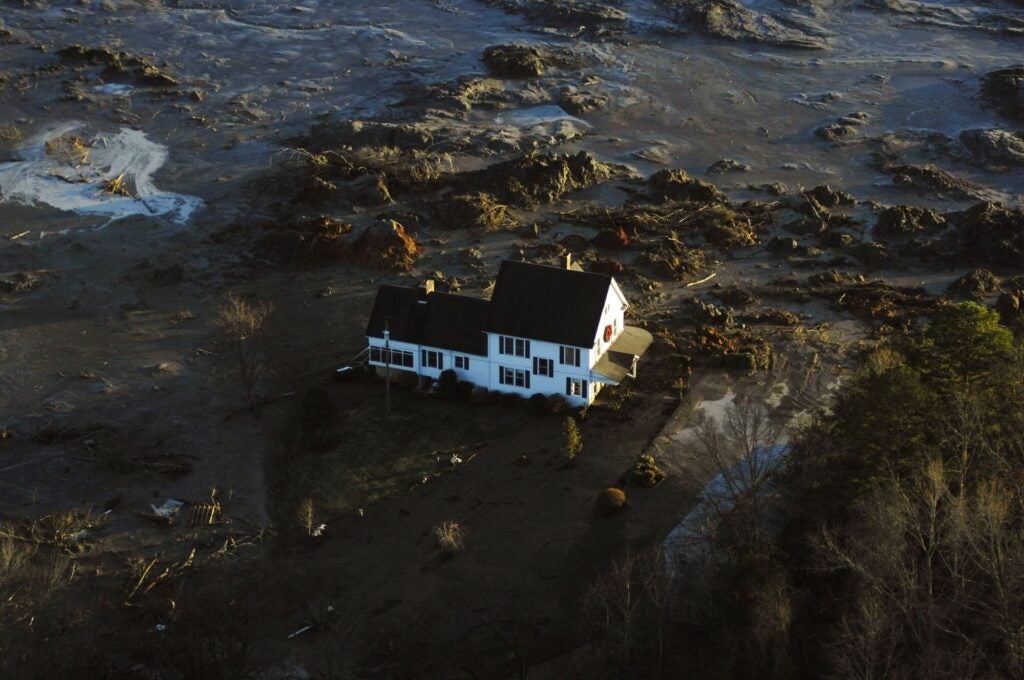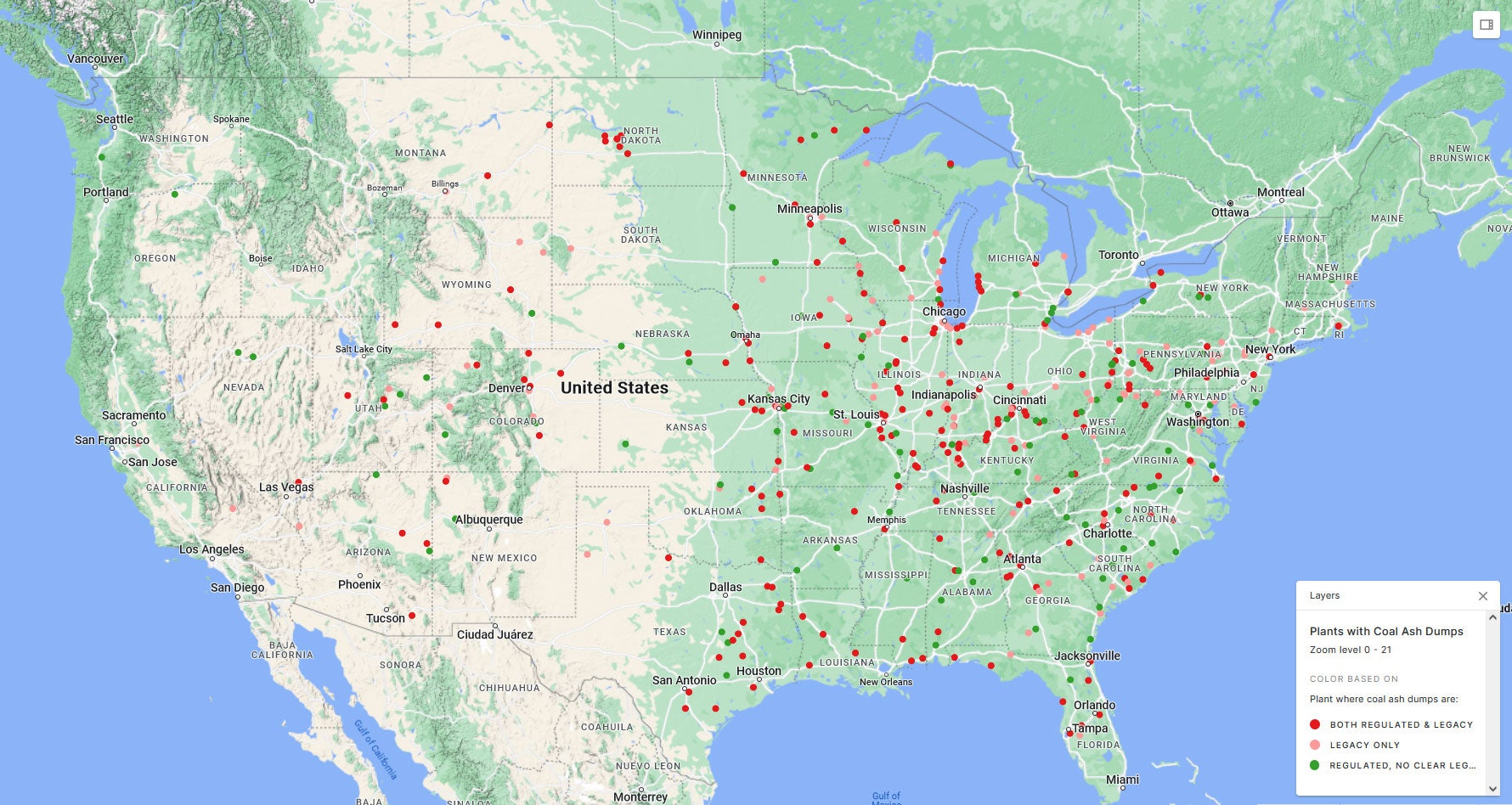May 4, 2023
Tennessee Valley Authority’s Toxic Coal Ash: Addressing Coal Plants’ Hazardous Legacy
For decades, utilities disposed of coal ash — the hazardous substance left after burning coal for energy — by dumping it in unlined ponds and landfills. The quasi-public utility, Tennessee Valley Authority (TVA), has a total of 56 coal ash dumpsites in Alabama, Kentucky, and Tennessee at 12 current and former coal plant sites.
After years of litigation and grassroots activism, on Apr. 25, 2024, the EPA issued a new rule that will force power plants to finally clean up their toxic coal ash. The EPA extended federal monitoring and cleanup requirements to hundreds of previously excluded older coal ash landfills and ponds that have been leaking toxic pollution into groundwater.
Note: Coal ash dumpsites referenced as “unregulated” throughout this page now are likely subject to federal regulation under the final rulemaking.
Coal ash contains hazardous pollutants including arsenic, boron, cobalt, chromium, lead, lithium, mercury, molybdenum, radium, selenium, and other heavy metals, which have been linked to cancer, heart and thyroid disease, reproductive failure, and neurological harm. In 2023, the EPA acknowledged that coal ash is even more dangerous than previously thought, with levels of arsenic and radiation that pose cancer risks.
Industry’s own data indicate that across the country 91% of coal plants are currently polluting groundwater above federal health standards with toxic pollutants.
Despite EPA’s 2015 Coal Ash Rule, which created the first-ever safeguards for coal ash disposal, many coal ash dumps remained unregulated due to sweeping exemptions for legacy coal ash ponds and inactive landfills. The exempted coal ash dumps are sited disproportionately in low-income communities and communities of color. The EPA extended clean up requirements to hundreds of old coal ash dumps across the country when it issued new regulations in the spring of 2024.

Coal ash remains one of our nation’s largest toxic industrial waste streams. U.S. coal plants continue to produce approximately 75 million tons every year.
In 2023, the EPA acknowledged widespread noncompliance with existing coal ash regulations and ramped up enforcement after designating coal ash a national enforcement priority.
Action Needed
The magnitude of harm from recklessly dumped toxic coal ash requires decisive action from federal and state regulators.
- TVA must be required to comply with the law and immediately clean up their pollution.
- EPA and states must act quickly to ensure that TVA leave communities with sites that benefit rather than harm their health, environment, and economic status.
- EPA must take action to prohibit the use of coal ash as construction fill and make polluters clean up areas where ash was used as fill.
29 Regulated Coal Ash Disposal Sites at TVA Coal Plants
TVA has ten coal plants that host 29 federally regulated coal ash ponds and landfills that contain approximately 119 million cubic yards of toxic waste.
At all of TVA’s coal plants, their own groundwater monitoring data indicate coal ash has caused significant groundwater contamination at regulated dumpsites.
TVA has failed to initiate any plant-wide cleanups to restore water resources despite the legal requirement to do so.
| Allen | Memphis | TN | 1 unlined pond, | Arsenic (x294), Boron (x4), Fluoride (x1), Lead (x3), Molybdenum (x9) |
| Bull Run | Clinton | TN | 2 unlined ponds, 1 landfill | Arsenic (x7), Boron (x9), Cobalt (x2), Lithium (x13), Molybdenum (x5), Sulfate (x3) |
| Colbert | Tuscumbia | AL | 1 unlined pond | Arsenic (x4), Boron (x2), Cobalt (x4) |
| Cumberland | Cumberland City | TN | 2 unlined ponds, 2 landfills | Arsenic (x1), Boron (x22), Cobalt (x3), Lithium (x2), Molybdenum (x1), Sulfate (x3) |
| Gallatin | Gallatin | TN | 3 unlined ponds, 1 landfill | Arsenic (x2), Boron (x6), Cobalt (x2), Lithium (x41), Molybdenum (x2), Sulfate (x1) |
| John Sevier | Rogersville | TN | 1 unlined pond | Lithium (x1) |
| Johnsonville | New Johnsonville | TN | 1 unlined pond | Boron (x4), Cobalt (x9), Sulfate (x1) |
| Kingston | Kingston | TN | 2 unlined ponds, 1 landfill | Arsenic (x16), Boron (x1), Cobalt (x20), Lithium (x10), Molybdenum (x5), Sulfate (x2) |
| Paradise | Drakesboro | KY | 6 unlined ponds, 1 landfill | Arsenic (x9), Boron (x21), Molybdenum (x1) |
| Shawnee | West Paducah | KY | 2 unlined ponds, 2 landfills | Boron (x2), Molybdenum (x3) |
All data on groundwater contamination from coal ash derived from the utilities’ publicly accessible CCR Compliance Data and Information websites, and exceedances were calculated by Environmental Integrity Project.
For more information on regulated coal ash sites in Alabama, Kentucky and Tennessee, see Mapping the Coal Ash Contamination.
27 Coal Ash Legacy Ponds and Inactive Landfills at TVA Coal Plants
March 2024 Update: The table below underestimates the legacy units that may be regulated by EPA’s upcoming CCR Legacy Pond Rule. Additional legacy units at specific plants may be found in the national map, above.
TVA coal plants also host at least 27 inactive coal ash landfills and legacy ponds that escaped federal regulation. The exact number remains unknown because utilities were not required to report these sites.
These dumps are almost certainly contaminating water and threatening health and the environment, however, monitoring data are not currently available for most unregulated sites.
Nevertheless, at all but one TVA plant with legacy ponds and landfills, current monitoring data and historical data both indicate significant groundwater contamination.
These data were developed by using EPA datasets relied upon in their 2007 and 2014 CCR risk assessments (Human and Ecological Risk Assessment of Coal Combustion Residuals) and comparing those datasets to the universe of regulated units.
“EPA damage case” denotes a site where US EPA has found documented groundwater contamination from coal ash.
For More Information
Christine Santillana, Senior Legislative Counsel, Earthjustice, csantillana@earthjustice.org
Lisa Evans, Senior Counsel, Earthjustice, levans@earthjustice.org.
More on Coal Ash
- Tennessee Valley Authority’s Toxic Coal Ash: Addressing Coal Plants’ Hazardous Legacy (May 3, 2023)
- Poisonous Coverup: The Widespread Failure of the Power Industry to Clean Up Coal Ash Dumps (November 3, 2022)
- Earthjustice Sues Kentucky Agency To Compel Release of Documents Related to Pollution at E.W. Brown Generating Station (August 22, 2018)
- We’re Fighting to Keep Coal out of a Kentucky Lake (January 29, 2018)
- Kentucky Utilities Announces It Will Phase Out Coal and Continue Transition to Clean Energy (November 14, 2017)
- Groups Sue To Protect Herrington Lake from Toxic Waste (July 12, 2017)
- Agreement Reached Over Water Discharge Dispute at LG&E’s Mill Creek Power Plant (September 23, 2016)
- Coal Ash Dump in Alabama's Black Belt: Another Symbol of Racism's Staying Power (February 17, 2016)
- NBC & CPI Series Spotlight Crucial Need for EPA Action on Race Discrimination (August 5, 2015)
- Statement on Tennessee Valley Authority's Decision to Retire the Allen Fossil Plant (August 21, 2014)
- Florida, Kentucky Rivers Poisoned by Coal Ash (June 10, 2014)
- A Toxic Inheritance (March 6, 2014)
- Defending Uniontown, AL from Toxic Coal Ash (March 10, 2014)
- Five Years Later and the Story of the TVA Spill Continues (December 23, 2013)
- Judge Holds TVA Liable For Kingston Disaster (August 28, 2012)
- One Year Later, a Coal Ash Disaster Still Remains (December 21, 2009)
- TVA Gets Permission to Further Pollute Clinch River (November 12, 2009)
- Coal Ash Disaster Could Have Been Avoided (July 30, 2009)
Coal Ash in States, Territories, Regions
Puerto Rico (En Español)
Earthjustice fights in the courts for a long-term solution to the toxic menace of coal ash. And we act on behalf of dozens of clients and over 100 coalition partners to defeat legislative attempts to subvert federally enforceable safeguards of coal ash.
Earthjustice’s Clean Energy Program uses the power of the law and the strength of partnership to accelerate the transition to 100% clean energy.
